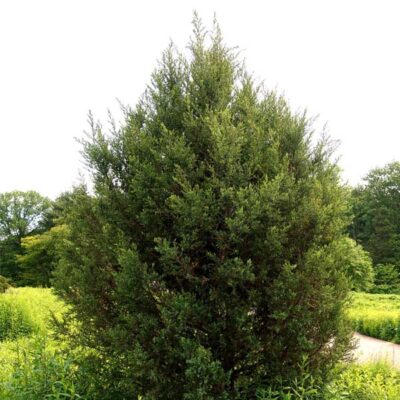Garden Plant: Eastern Red Cedar Tree
Product Description: Eastern Red Cedar Tree

Birds Love Native Eastern Red Cedar Tree
- Native Evergreen
- Tough, Durable and Drought Resistant
- Wildlife Cover and Bird Magnet
- Wonderful Texture
- Aromatic Wood
The Eastern Red Cedar (Juniperus virginiana) is one tough old native tree that you can respect. You can find it growing in the wilds of North America – from the eastern seaboard all the way through the country, as far west as Texas and north into South Dakota. You’ll see these wild trees flourishing in the harshest of conditions.
Hot and dry sites where road salt and open exposed areas won’t even make this plant flinch. Air pollution, shallow and rocky soils, even soils where Black Walnut grows won’t affect the Eastern Red Cedar tree. Deer usually pass on this one, too.
If You’re a bird-lover, this is the evergreen tree for you. Eastern Redcedar will attract birds, including generations of song and game, robins, juncos, warblers, sparrows, quail, grouse, pheasants and wild turkeys. They’ll happily work on nesting and roosting in the branches.
The bark is reddish brown and has a shredding nature that is hidden from view but useful for bird nest construction. Tiny, dark blue, berry-like cones produced by the female tree are a valuable food source for many species of birds.
You’ll enjoy a range of colors that start with silvery blue to dark green foliage during the growing season. In the fall and winter, it changes to a purplish color that makes a beautiful accent against your home and outbuildings. Embrace that winter color.
Order now for best selection!
How to Use Eastern Red Cedar Tree in the Landscape
Plant several along your driveway so you can enjoy the rich, cedar aroma as you arrive home and screen off the neighbor at the same time. Kids of all ages love this rugged, earthy fragrance. The scent will easily connect you to the natural world and ground you in a few moments. What a nice transition for you to shake off your workday.
People also love to clip sprigs for use indoors during the holiday season. They make wonderful wreaths or cut boughs for an invigorating bouquet.
Woodworkers, take note. The dark red heartwood is easy to work with, is rot resistant and weathers beautifully. It is the wood used to make cedar chests.
Eastern Red Cedar grows with a dense and shaggy texture, but the plants are mostly pyramidal in shape. They look their best if allowed to grow in their natural form. It’s a fantastic look for a rustic or contemporary property.
Use for screening, windbreaks and shelterbelts, or even a specimen plant for open areas with full sun or partial sun. Try them at the edge of more formal gardens, too, in a sly nod to the transition between manicured and wilderness.
Be sure to include seating nearby, as these trees will deliver incredible bird-watching opportunities.
Pro Plant Tips for Care
Red Cedar will grow in almost any soil with only one exception… they hate soil that is consistently wet. Once established with a bit of careful attention to water, the plants will become completely self-sufficient and very drought tolerant.
Hardy and easy to transplant, the Eastern Red Cedar is a low maintenance tree that will adapt to almost any conditions and provide you years of enjoyment.
Please note that We use Plant Sentry to stop shipments into areas where this tree does a little “too well. ” It’s also best to plant this tree at least 500 feet away from Apple trees to prevent potential Cedar-Apple rust. (Nothing should get in the way of a good Apple crop!)


